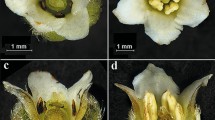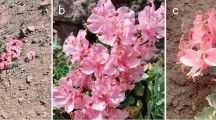Abstract
In the seagrassPhyllospadix scouleri (Zosteraceae) floral aggregates (spadices) occur on short lateral axes produced by subordinate vegetative shoots. The filamentous pollen is both dispersed on the surface of the sea as well as below the surface. In surface pollination, snowflake-like search vehicles (pollen rafts) float and collide with any rigid female inflorescences that emerge from the water surface. In submarine pollination, collinear bundles of pollen grains are dispersed. Analysis of seed set indicates ovule position within the inflorescence to affect likelihood of fertilization in submarine, but not surface-pollinated inflorescences. Agamospermy appears to be unlikely, but the strongly female-biased shoot sex ratio remains to be explained.
Similar content being viewed by others
References
Cox, P. A., 1983: Search theory, random motion, and the convergent evolution of pollen and spore morphologies in aquatic plants. — Amer. Naturalist121: 9–31.
—, 1988: Hydrophilous pollination. — Ann. Rev. Ecol. Syst.19: 261–280.
—, 1990: Hydrophilous pollination of a dioecious seagrass,Thalassodendron ciliatum (Cymodoceaceae), in Kenya. — Biotropica22: 259–265.
—,Knox, R. B., 1988: Pollination postulates and two-dimensional pollination in hydrophilous monocotyledons. — Ann. Missouri Bot. Gard.75: 811–818.
—, —, 1989: Two-dimensional pollination in hydrophilous plants: convergent evolution in the generaHalodule (Cymodoceaceae),Halophila (Hydrocharitaceae),Ruppia (Ruppiaceae), andLepilaena (Zannichelliaceae). — Amer. J. Bot.76: 164–175.
—,Tomlinson, P. B., 1988: The pollination ecology of a Caribbean seagrass,Thalassia testudinum (Hydrocharitaceae). — Amer. J. Bot.75: 958–965.
De Cock, A. W. A. M., 1980: Flowering, pollination, and fruiting inZostera marina L. — Aquatic Bot.9: 202–220.
Delpino, F., Ascherson, P., 1871: Federico Delpino's Eintheilung der Pflanzen nach dem Mechanismus der dichogamischen Befruchtung und Bemerkungen über die Befruchtungsvorgänge bei Wasserpflanzen. Mitgetheilt und mit einigen Zusätzen versehen von P. Ascherson. — Bot. Zeitung (Berlin)29: 443–445, 447–459, 463–467.
Den Hartog, C., 1970: The seagrasses of the world. — Verhandl. Kon. Nederl. Akad. Wetensch. Nat.59 (1). — Amsterdam: North Holland.
Doty, M. S., Archer, J. G., 1950: An experimental test of the tide factor hypothesis. — Amer. J. Bot.37: 458–464.
Dudley, W. R., 1893: The genusPhyllospadix. — In The Wilder Quarter-Century Book, pp. 403–418. — Ithaca, New York: Comstock.
—, 1894:Phyllospadix, its systematic characters and distribution. — Zoe4: 381–385.
Ernst-Schwarzenbach, M., 1944: Zur Blütenbiologie einiger Hydrocharitaceen. — Ber. Schweiz. Bot. Ges.54: 33–69.
Faegri, K., Van Der Pijl, L., 1979: The principles of pollination ecology. 3rd edn. — Oxford: Pergamon Press.
Harada, I., 1944: Sex chromosome ofPhyllospadix. — Japan J. Genet.20: 127–128.
Knuth, P., 1898: Handbuch der Blütenbiologie. Band I, II. — Leipzig: W. Engelmann.
McMillan, C., Phillips, R. C., 1981: Morphological variation and isozymes of North AmericanPhyllospadix (Potamogetonaceae). — Canad. J. Bot.59: 1494–1500.
Phillips, R. C., 1979: Ecological notes onPhyllospadix (Potamogetonaceae) in the Northeast Pacific. — Aquatic Bot.6: 159–170.
Stewart, J. G., Rudenberg, L., 1980: Microsporocyte growth and meiosis inPhyllospadix torreyi, a marine monocotyledon. — Amer. J. Bot.67: 949–954.
Tomlinson, P. B., 1982:Helobiae (Alismatidae) VII. — InMetcalfe, C. R., (Ed.): Anatomy of the Monocotyledons. — Oxford: Clarendon Press.
Troll, W., 1931: Botanische Mitteilungen aus den Tropen II. Zur Morphologie und Biologie vonEnhalus acoroides (Linn. f.)Rich. — Flora (Jena)125: 427–456.
Turner, T., 1985: Stability of rocky intertidal surfgrass beds: persistence, preemption, and recovery. — Ecology66: 83–92.
—,Lucas, J., 1985: Differences and similarities in the community roles of three rocky intertidal surfgrasses. — J. Exper. Mar. Biol. Ecol.89: 175–189.
Wiens, D., 1984: Ovule survivorship, brood size, life history, breeding systems, and reproductive success in plants. — Oecologia64: 47–53.
Author information
Authors and Affiliations
Rights and permissions
About this article
Cite this article
Cox, P.A., Tomlinson, P.B. & Nieznanski, K. Hydrophilous pollination and reproductive morphology in the seagrassPhyllospadix scouleri (Zosteraceae). Pl Syst Evol 180, 65–75 (1992). https://doi.org/10.1007/BF00940398
Received:
Revised:
Accepted:
Issue Date:
DOI: https://doi.org/10.1007/BF00940398




